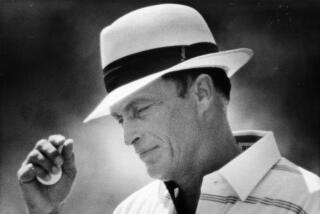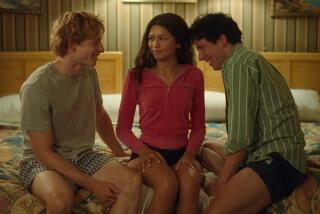His Game Is Bucking the System
- Share via
As noted before, tennis is the only game I know where love is merely a score, hate is a way of life, deuces are wild and the scoring system seems to have been invented by the Mad King of Bavaria or someone in a rubber room wearing a straitjacket.
Football is a little funny (why do touchdowns count 6?), but tennis is in a class by itself. How come a first point is 15, then the second is 30, then--get this!--the third point is 40? If you can spot a trend there, Middle East politics should be an open book to you. You wonder they don’t keep score by square roots.
But, in a way, if I were a player like Michael Chang, I would be ticked off at what they did to tennis scoring a few years back. They did away with the long, inconclusive multigame sets and put in something called the Van Alen scoring system known colloquially as the “tiebreaker.”
As usual, it wasn’t simple. Tennis despises simplicity. A Davis Cup tournament, to give you an idea, is known as a “tie.” As in old school, I should guess.
The tiebreaker is kind of the tennis version of showdown poker. It was put in to do away with those interminable matches in which sets would run up to 24-24 or end up 30-28. Spectators would be a wreck, their necks would be sore from swiveling, their eyes watery and their heads aching. So would players.
The Van Alen system, devised by James Van Alen, who died recently, provided no set would go beyond 7-6, unless it was in the fifth set of a major event such as the Davis Cup or Wimbledon. As usual, you had to win the tiebreaker by two points. Tennis is in love with the two-point-must system. It’s one of the few sports where a simple single point won’t do. Baseball games can end up 2-1, football can end up 21-20, even in basketball, hockey or soccer, a one-point victory is not only OK, it’s commonplace.
I guess that’s what tennis dislikes--the word common.
Anyway, guys like Michael Chang should sue the game. You see, tennis, like most sports, has the yin and yang, the home run hitter and the bunt-and-stealer, the quarterback with the bomb and the quarterback who has to get his scores 10 yards at a time. The slugger and the boxer. The line-drive hitters vs. the good glove men. Goalies vs. slap-shooters.
What you have to do if you don’t have the 140-m.p.h. serve and the 120-m.p.h. follow-up volley, is, you run the legs off those who do, you keep the ball in play hour after hour. You wear out their concentration. The 40-game set is right down your court.
Michael Chang is not your basic cannonball server. No one ever called him the Rocket or the Comet. What Michael brings is tenacity, athleticism and, basically, undiscourageability.
It seems as if those qualities have gone out of style. Wimbledon’s grass courts have pretty much offered up a succession of big hitters with about as much finesse as a hillside strangler.
The service ace is probably the most boring thing in sports next to the foul tip or falling on the ball on your own 40. It’s the tennis version of the slam dunk. It doesn’t really demand talent, merely power. Height and strength.
Michael Chang can play all parts of tennis, but he’s like a pug who has to make his fight with jabs and moves and clinches. An ideal surface for him would be the La Brea Tar Pits. When he gets Boris Becker on grass, it’s like getting a lion in a cellar.
What you have to do when you’re outgunned, every general knows, is you resort to guerrilla warfare. You blow up trains. You want every match to go to five sets, every game to deuce--and you wish James Van Alen had minded his own business.
They changed the scoring system because it was too grueling the other way. But, you want gruel, so to speak. You want to make the other guy to take five hours to eliminate you.
The baseline is your office. You make up in heart what you lack in velocity. You substitute speed of foot for speed of serve. You have to be as steady getting the ball back as a garage door.
Michael Chang shocked the tennis world two years ago when he became the youngest man ever to win a Grand Slam event, taking the French Open title at 17. He didn’t do it by dynamiting his opponents off the (red clay) courts. He did it by coming back from two sets down to Ivan Lendl and down, 2-1, in sets to Stefan Edberg.
Chang takes on the power tennis elite in the 1991 Volvo Tennis/Los Angeles tournament at UCLA next week. It is a (hard court) tournament in which he has been finalist two years in a row, losing to Edberg last year and Aaron Krickstein in ’89.
In some sports, you can bulk up with weightlifting, steroids or both. In tennis, that doesn’t work, Chang says. “Bulk doesn’t work in tennis. I just need to be more aggressive.”
What he needs is a 15-round fight. With the Van Alen shootout, the game becomes a six-round toe-to-toe slugfest with a premium on the big sock or serve. Chang doesn’t want to trade punches, he wants to match staminas.
More to Read
Go beyond the scoreboard
Get the latest on L.A.'s teams in the daily Sports Report newsletter.
You may occasionally receive promotional content from the Los Angeles Times.










